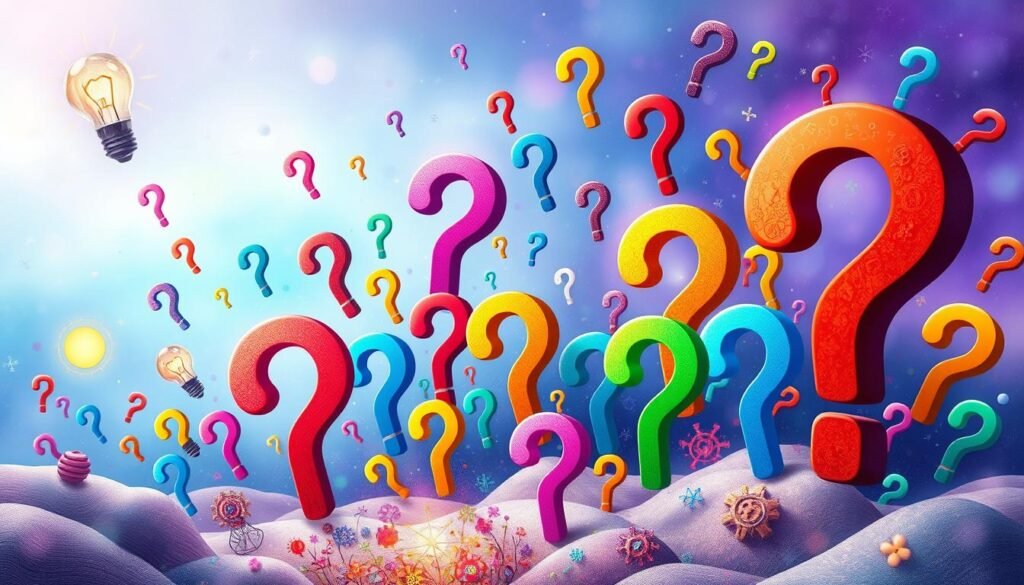Did you know ChatGPT can save you up to 75% of time writing from scratch1? To get the most out of it, you need to learn how to write great prompts. The secret is knowing how to write in a style that gets ChatGPT to give you the best answers.
In this guide, we’ll show you the best ways to write ChatGPT prompts. We’ll cover how to be clear, simple, and friendly. You’ll learn how to make your prompts engaging and get top-notch results.
Key Takeaways
- Understand the importance of writing style in crafting effective ChatGPT prompts
- Learn how to be clear, specific, and concise in your prompts to optimize audience engagement
- Discover the power of using action-oriented language and open-ended questions to encourage thoughtful responses
- Explore techniques for breaking down complex requests and providing necessary context
- Leverage ChatGPT’s own analysis to refine your prompt writing skills and achieve better outcomes
The Importance of Writing Style in ChatGPT Prompts
When you talk to ChatGPT, how you write your prompts matters a lot. The impact of writing style on ChatGPT responses can greatly affect the quality and relevance of what the AI says. By writing your ChatGPT prompts well, you can get answers that are more focused, tailored, and engaging. These answers will really connect with your audience2.
Why Choosing the Right Writing Style Matters
The importance of prompt style in ChatGPT interactions is huge. Your writing style sets the tone and guides the whole conversation with the AI. Writing clearly, concisely, and conversationally can lead to natural and meaningful talks. But, a formal or disjointed style might result in less effective or confusing answers2.
The Impact of Writing Style on Audience Engagement
Writing compelling ChatGPT prompts that optimize audience engagement is key. By using a writing style that matches your audience, you can get more thoughtful and valuable responses from ChatGPT. This can make the interaction more engaging and productive, improving the user’s experience2.
To get the most out of ChatGPT, understanding the nuances of writing style for ChatGPT prompts is essential. By mastering this, you can create more effective and meaningful interactions. This can lead to better outcomes for your users2.
“Crafting the right writing style for your ChatGPT prompts can be the difference between a productive conversation and a missed opportunity.”
| Effective ChatGPT Prompt Writing | Ineffective ChatGPT Prompt Writing |
|---|---|
|
|
By understanding the importance of writing style in ChatGPT prompts and using best practices, you can craft more effective and engaging content. This content will truly resonate with your audience23.
Be Clear and Specific
When writing ChatGPT prompts, clarity is key4. Vague prompts can lead to confusing answers because the AI doesn’t know what you want5.
The Benefits of Precise and Focused Prompts
Clear prompts help the AI give you better answers that match your needs5. They lead to more accurate and relevant responses. Using simple language makes it easier for the AI to understand and respond correctly5.
Adding action words like “explain” or “list” makes answers more structured5. Short prompts get more direct answers from the AI5. Open-ended questions can give deeper insights5. Including context makes the AI’s answers more relevant to you5.
Learning to write clear prompts unlocks ChatGPT’s full power4. Precise prompts lead to better, more tailored responses from the AI5.
| Prompt Characteristic | Benefit |
|---|---|
| Specific | Yields more accurate and focused responses |
| Simple language | Aids comprehension and response effectiveness |
| Action words | Lead to more structured answers |
| Concise | Result in more relevant and on-point responses |
| Open-ended | Elicit more detailed and nuanced answers |
| Providing context | Helps tailor responses to specific needs |
Using these tips in your ChatGPT prompts can greatly improve your experience4. Clear prompts are essential for getting the most out of this AI assistant5.
Use Simple Language
When making prompts for ChatGPT, keep it simple and clear. Stay away from hard words, technical terms, and complicated sentences. These can confuse the AI and make its answers less good6. Use simple, everyday words that ChatGPT can understand well. This makes sure your prompts are clear, helping the AI give better answers6.
Simple language in ChatGPT prompts has many benefits. It helps you and the AI talk better7. When your prompts are easy to get, ChatGPT can understand what you really want, without getting lost in hard words7.
Also, simple language makes your prompts easier for more people to get8. Whether for personal or work use, clear prompts mean everyone can understand the content8.
To write simple prompts for ChatGPT, use common words and phrases. Avoid jargon, technical terms, and formal language7. Go for a friendly, natural tone7. This way, your prompts will work well for the AI and your readers.
“The true sign of intelligence is not knowledge, but imagination.” – Albert Einstein
Utilize Action Words
Creating effective ChatGPT prompts means using action words9. Verbs like “identify,” “describe,” “explain,” and “analyze” tell ChatGPT what you want. This makes the AI’s answers more focused and meaningful9.
Effective Use of Action Verbs in Prompts
Starting prompts with action words like “describe” or “list” helps ChatGPT understand what you need9. This clear direction makes the AI’s answers more relevant and useful9.
Action words also push ChatGPT to think deeper, like analyzing or solving problems9. For instance, asking it to “Analyze the pros and cons of…” encourages detailed insights9.
Using action words in prompts makes ChatGPT’s answers better and more tailored9. This way, you get more value from your conversations with the AI9.
Keep It Concise
When making prompts for ChatGPT, keep it short10. Short prompts are clear and get straight to the point10. Too much info can confuse ChatGPT and lead to bad answers10.
Writing concise prompts is very important10. Short, focused prompts are easier for ChatGPT to understand10. This leads to better and more fun chats10.
To make your prompts better, try these tips:
- Use strong verbs to get your point across10.
- Get rid of words like ‘very’ and ‘really’10.
- Don’t add adverbs or adjectives that aren’t needed10.
- Break long sentences into shorter ones10.
By using these tips, you can make your prompts clear and effective10. The goal is to give ChatGPT clear instructions10.
“Focus on delivering the essential points in fewer words while keeping the main message clear.”10
| Key Strategies for Concise Prompts | Benefits |
|---|---|
| Eliminate redundancies | Streamlines the prompt, reducing unnecessary information |
| Use an active voice | Promotes direct and engaging communication |
| Choose precise words | Ensures the prompt is clear and unambiguous |
Ask Open-Ended Questions
Open-ended questions are key to getting deeper, more thoughtful answers from ChatGPT11. Unlike closed-ended prompts, which get simple “yes/no” answers, open-ended questions let ChatGPT dive deeper. This way, you get broader, more insightful responses11.
This method helps you get the most out of ChatGPT. It makes your conversations more engaging and productive.
Encouraging Deeper and More Thoughtful Responses
Using open-ended questions in your prompts makes ChatGPT explore topics more deeply11. It shares its knowledge and views in a more detailed way11. This leads to richer, more nuanced answers and a more engaging dialogue.
- Open-ended questions start with words like “why,” “how,” “what if,” or “describe” to get detailed responses11.
- For example, instead of asking “What is the capital of France?” (a closed-ended question), you can ask “Describe the historical and cultural significance of Paris as the capital of France.”11
- This type of prompt lets ChatGPT explore the topic deeply, giving a more detailed and engaging response11.
Learning to ask open-ended questions unlocks ChatGPT’s full power11. It’s great for tackling complex topics, getting original ideas, or getting unique views from the AI.

“With open-ended questions, you can transform ChatGPT into a true writing partner, unlocking its ability to provide thoughtful, nuanced responses that can inspire your own creativity and deepen your understanding of a subject.” – ChatGPT Prompt Writing Expert
The secret to great open-ended prompts is to ask questions that make ChatGPT explore, analyze, and share its knowledge deeply11. By getting good at this, you can make your chats with the AI more rewarding and productive1112.
Provide Context When Necessary
Creating effective ChatGPT prompts is more than just using simple language13. Adding context to your prompts can greatly shape the AI’s response. This ensures the AI gives you information that fits your specific needs13. Context helps ChatGPT understand your query better, making its answers more relevant and useful.
Imagine asking ChatGPT to “Explain the concept of machine learning.” This prompt is clear but might get a general answer13. But, if you add more context, like “Explain the concept of machine learning and how it is used in image recognition,” the AI can give a more specific answer13.
Adding context to your prompts is key for complex topics13. It helps ChatGPT understand the background and what you need. This makes the conversation more focused and productive13. It also shows you know how to communicate your needs well to the AI.
As you use ChatGPT more, remember that context is a powerful tool13. Including relevant details in your prompts can make your interactions with ChatGPT more valuable and tailored to your needs13.
The Importance of Contextual Information in ChatGPT Interactions
Adding context to your ChatGPT prompts has many benefits:13
- It helps the AI give more targeted and relevant answers13
- It narrows down the query, reducing generic or irrelevant responses13
- It shows you understand the topic and can communicate your needs well13
- It lets the AI tailor its response to your specific situation or needs13
By focusing on context in your ChatGPT interactions, you can get the most out of this AI assistant. You’ll get answers that are valuable, tailored, and meet your specific needs13.
Embrace a Conversational Tone
When you write ChatGPT prompts, using a friendly tone makes them more natural and fun14. Stay away from formal language and go for something relaxed and casual15. This way, ChatGPT can give you answers that feel like they’re coming from a real person15.
Writing in a friendly way has many perks14. It helps you connect with ChatGPT on a personal level, making your chats feel more real15. Plus, your prompts will be more fun and easy to remember because they’re like how you talk every day16. This also means ChatGPT will give you answers that are more thoughtful and detailed.
To get the friendly vibe right, use simple words that feel like everyday talk16. Skip the fancy terms and go for something easy to understand15. You can also add fun elements like funny stories or open-ended questions to make your chats more lively.
By using a friendly tone in your ChatGPT prompts, you’ll get a better chat experience141516. You’ll build trust and rapport with ChatGPT, leading to answers that really meet your needs.

Break Down Complex Requests
When you have complex ChatGPT prompts, it’s smart to split them into smaller parts. This makes your requests clearer and more focused. It ensures each part gets the right attention from the AI17. This way, you avoid confusion and get detailed answers from ChatGPT.
Organizing Multi-Part Prompts for Better Clarity
Complex prompts often have many parts or need to cover several points. To make them clearer, break them into smaller, focused questions18. This method lets you tackle each part one by one. It helps the AI give you structured and helpful answers.
- Find the main elements or questions in the prompt.
- Split the prompt into clear parts, one at a time.
- Make short, direct sub-prompts for each part.
- Make sure your sub-prompts have all the needed details and context.
- Arrange your sub-prompts in a logical order for a smooth flow.
Breaking down complex requests this way improves clarity and addresses each part well1718.
The aim is to give ChatGPT clear, organized instructions. This lets the AI give you more useful and practical answers19. By breaking down complex chatgpt prompts and organizing multi-part prompts for chatgpt, your chats with the AI model will be better.
best writing style for chatgpt prompts
Writing good prompts for ChatGPT needs careful thought. By using the right techniques, you can get clear and interesting answers from the AI6.
First, use simple words. Avoid complicated language and go for a friendly tone. This makes it easier for ChatGPT to understand and answer6.
Next, add action words to your prompts. Words like “explain” or “describe” tell ChatGPT what to do6. This helps make your prompts clear and gets better answers from the AI.
Also, break down big requests into smaller parts. This method, called “prompt chunking,” makes your prompts clearer and gets better answers from ChatGPT6.
By writing clearly and concisely, you can make the most of ChatGPT6. Keep trying new things and improving your writing to get even better answers from the AI over time.
“Crafting effective ChatGPT prompts is as much an art as it is a science. By mastering the nuances of writing style, you can unlock the full potential of this powerful AI assistant.”

| Writing Style Characteristic | Key Considerations |
|---|---|
| Personal and Engaging Tone | The writing conveys a friendly and engaging tone7. |
| Informative and Clear Content | Detailed and informative writing with clear instructions or insights7. |
| Use of Casual Language and Emojis | Inclusion of casual phrases and emojis to enhance reading experience7. |
| First-Person Narrative | Writing style includes a first-person narrative for personal touch7. |
| Use of Visuals and External Links | Incorporation of images, GIFs, and external links for enriched content7. |
| Structured and Organized Content | Well-structured with headings, subheadings, and lists for clarity7. |
| Encouragement and Positive Affirmations | Usage of encouraging phrases for a supportive environment7. |
| Humor | Light humor integrated into the text for a more enjoyable read7. |
By using these tips, you can make ChatGPT prompts that get the best answers67. Keep trying new things and improving your writing to get even better answers from the AI over time.
Reverse Engineering ChatGPT’s Writing Analysis
To get the most out of ChatGPT, it’s key to know how it sees and judges writing styles. By figuring out how ChatGPT analyzes writing, you can find content that fits your style. Then, you can ask the AI to describe that style20.
This method helps you understand ChatGPT’s view on good writing. You can then make prompts that match the AI’s perspective. This makes your interactions with ChatGPT more successful and productive.
Understanding How ChatGPT Perceives Writing Styles
ChatGPT has 200 million weekly users, showing it’s a big deal in SEO20. The WebBrowser Assistant is a tool for ChatGPT prompts. It adds Bing results to make conversations more accurate and relevant20.
ChatGPT is open about its decision-making. This lets users see why it gives certain answers. It’s also important to check the facts ChatGPT provides to make sure your content is right20.
Ryan uses TextExpander to save and improve ChatGPT prompts for writing analysis21. Giving ChatGPT detailed prompts helps get more consistent results21. ChatGPT is also used to check technical memos for their purpose, format, and content21.
Knowing how ChatGPT views good writing helps you make better prompts. This is great for tasks like keyword research, optimizing content for featured snippets, and writing meta descriptions for SEO20.
But, it’s important to keep your own creativity and control in your work. Use ChatGPT as a tool, not a replacement20. The article advises to keep working on ChatGPT’s answers until they match your style and message20.
By understanding ChatGPT’s writing analysis, you can create content that really speaks to your audience. This knowledge helps you make prompts that align with ChatGPT’s view. This leads to more engaging and effective content.
Find Exemplary Content in Your Desired Style
To reverse engineer ChatGPT’s writing analysis, start by finding content that matches the style you want to copy22. Look at examples of great writing to learn what makes them effective. This helps you create a “Personal Swipe File” with top-notch material for ChatGPT prompts22.
When searching for content, aim for pieces that are clear, concise, and easy to talk to23. Look at articles, blog posts, or transcripts that show the writing style you admire22.
Using existing content to spark your prompts can teach you new techniques23. Keeping a personal swipe file also keeps your prompts consistent and effective22.
“Crafting effective prompts for ChatGPT involves providing clear and specific phrases and instructions.”23
Success comes from continuously experimenting and improving your prompts. Use a wide variety of quality content for inspiration23.

Ask ChatGPT to Analyze the Writing Style
First, find good examples of writing. Then, use ChatGPT’s own writing analysis capabilities to learn about the style and techniques. You can ask the AI to break down the writing style, including tone, structure, and language24.
Understanding ChatGPT’s view on good writing helps you write better prompts. These prompts will match the AI’s likes and understanding25.
To ask ChatGPT about writing style, say something like this:
“Analyze the writing style of this text. Describe the tone, structure, word choice, and any other relevant stylistic elements you observe.”
ChatGPT will give you a detailed review of the writing style. It will point out what works well and what could be better25.
This feedback is key to improving your prompting skills. Knowing ChatGPT’s view on writing styles lets you use the AI’s strengths to create content that hits the mark2425.
Keep asking ChatGPT for its analysis and feedback on your writing. This will help you keep getting better at writing prompts and make your content more effective25.
Turn ChatGPT’s Analysis into a Prompt
The last step is to use ChatGPT’s writing style analysis to make great prompts. By making prompts that match ChatGPT’s writing skills, you get better responses26. You need to be clear about what you want, how you want it, and what to avoid26.
Crafting Prompts Based on ChatGPT’s Understanding
ChatGPT is very good at many things. It can use your templates, make your content better, and even organize messy notes26. By making prompts that fit ChatGPT’s strengths, you get top-notch content that matches your brand26.
ChatGPT can make lists of actions and subtopics with questions to help with ideas26. It can also change the tone and perspective of content, making it easy to compare and improve26. It’s great for journaling, coming up with headlines, and making ideas clear and organized26.
Knowing how ChatGPT sees and responds to writing styles helps you make better prompts27. This leads to more creative and relevant content27. Try different prompts, personas, and styles to get the most out of ChatGPT27.

To succeed, keep trying and improving your prompts. Stay up to date with ChatGPT’s new features and likes27. With practice, you can use ChatGPT to create content that really connects with your audience27.
Continuously Improve Your Prompting Technique
Writing good ChatGPT prompts is a journey that never ends28. By always looking to get better, you can make your prompts more effective. This leads to better chats with ChatGPT over time28.
To get better at writing ChatGPT prompts, pay close attention to how they work out29. See what’s working and what needs tweaking29. Focus on making your prompts clear, short, and to the point. This makes ChatGPT’s answers better29.
- Make your prompts better based on what happens29. If a prompt doesn’t work, figure out why and fix it29.
- Keep trying different ways to make your prompts better30. Try adding more details, using the right words, or breaking down big questions into smaller ones30.
- Keep changing how you write prompts as you learn more28. Update your methods to keep up with ChatGPT’s growth and your changing needs28.
By always trying to get better, you can make the most of ChatGPT28. It helps you work smarter, think more creatively, and solve problems better28. Remember, getting good at writing prompts is a long-term effort. The more you use ChatGPT, the better you’ll get at making it work for you29.
“The more you experiment and refine your ChatGPT prompts, the better you’ll become at tailoring them to your specific needs and goals.”
| Prompt Technique | Description | Key Benefit |
|---|---|---|
| Refining Prompts | Analyzing prompt results to identify areas for improvement | Enhances prompt effectiveness over time |
| Iterating on Prompts | Experimenting with different prompt approaches | Leads to better outcomes and more successful interactions |
| Evolving Strategies | Adapting prompt techniques to match ChatGPT’s evolving capabilities | Ensures continuous improvement and relevance |
By always working to improve your ChatGPT prompts, you can unlock its full power28. The key is to see prompt writing as a never-ending process of getting better, trying new things, and adapting29.
Conclusion
This article has shown how important writing style is for making great ChatGPT prompts31. Using clear, simple language and a friendly tone helps the AI give better answers32. It also talked about how to make prompts better by learning from ChatGPT itself32.
Key points for making ChatGPT prompts better include using the right writing style and being clear31. It’s also important to use action words and talk like you’re having a conversation31. Plus, breaking down big requests and always getting better at prompting is key.
The article stresses the need to understand and match ChatGPT’s writing style32. It also points out the importance of keeping your prompting skills sharp32. By following these tips, you can get the most out of ChatGPT and improve your writing and creativity31.
FAQ
What is the importance of writing style in ChatGPT prompts?
What are the benefits of using clear and specific prompts for ChatGPT?
Why is it important to use simple language in ChatGPT prompts?
How can incorporating action words into ChatGPT prompts be beneficial?
What are the advantages of keeping ChatGPT prompts concise?
How can open-ended questions be effective for ChatGPT prompts?
When should users provide additional context in ChatGPT prompts?
What are the benefits of using a conversational tone in ChatGPT prompts?
How can breaking down complex prompts be helpful for ChatGPT?
How can users leverage ChatGPT’s own writing analysis to improve their prompt writing?
Source Links
- How to Get ChatGPT to Write Like You (Or Better) – https://medium.com/@mfishbein/how-to-get-chatgpt-to-write-like-you-8481b75bb462
- Discover the Engaging ChatGPT Prompts Writing Style – https://neuroflash.com/blog/discover-the-engaging-chatgpt-prompts-writing-style-for-hypnotic-content-creation/
- How to Create an AI Style Guide: Write With ChatGPT in Your Own Voice – https://fortelabs.com/blog/how-to-create-an-ai-style-guide-write-with-chatgpt-in-your-own-voice/
- 50+ Most Useful Writing Styles for ChatGPT Prompts – https://www.learnprompt.org/writing-styles-for-chat-gpt-prompts/
- 10 Best Writing Style for ChatGPT Prompts – https://medium.com/@suhanahamid789/10-best-writing-style-for-chatgpt-prompts-0d25eebf6da3
- How to train ChatGPT to write like you | Zapier – https://zapier.com/blog/train-chatgpt-to-write-like-you/
- How to Train ChatGPT to write like you – It’s That Lady Dev – https://itsthatlady.dev/how-to-train-chatgpt-to-write-like-you/
- Train ChatGPT To Write Like You In 5 Easy Steps – https://www.forbes.com/sites/jodiecook/2023/06/15/train-chatgpt-to-write-like-you-in-5-easy-steps/
- Write the perfect ChatGPT prompts in 5 easy steps! – neuroflash – https://neuroflash.com/blog/chatgpt-how-to-write-the-perfect-prompts/
- ChatGPT Prompts that Make Your Writing More Concise – https://cowriter.ai/blog/chatgpt-prompts-that-make-your-writing-more-concise
- 50 Best ChatGPT Prompts for Writing | ClickUp – https://clickup.com/blog/chatgpt-prompts-for-writing/
- Need Help With Prompts? Ask me* – https://community.openai.com/t/need-help-with-prompts-ask-me/21612
- 8 Best Writing Style for ChatGPT Prompts – https://www.linkedin.com/pulse/8-best-writing-style-chatgpt-prompts-suhana-hamid-dtodf
- ChatGPT Style Guide: Understanding Voice and Tone Prompt Options for Engaging Conversations – https://www.relataly.com/chatgpt-style-guide-understanding-voice-and-tone-options-for-engaging-conversations/13065/
- ChatGPT and Tone: Avoid Sounding Like a Robot – https://www.nngroup.com/articles/chatgpt-and-tone/
- Writing Better ChatGPT Prompts: Complete Guide – Something Incorporated – https://somethinginc.com/blog/writing-better-chatgpt-prompts-complete-guide/
- 60+ Best Writing Styles For ChatGPT Prompts – Workflows – https://www.godofprompt.ai/blog/60-best-writing-style-for-chatgpt-prompts
- Unlocking the Power of Content Creation – Content Hacker – https://contenthacker.com/chatgpt-prompts/
- 15+ Best ChatGPT Prompts for Writing – https://www.bloggingpro.com/chatgpt-prompts-for-writing/
- How To Write ChatGPT Prompts To Get The Best Results – https://www.searchenginejournal.com/how-to-write-chatgpt-prompts/479324/
- Prompt Engineering for ChatGPT with TextExpander – https://textexpander.com/blog/prompt-engineering-for-chatgpt-with-textexpander
- Mastering ChatGPT Prompts: Strategies & Examples for Crafting Effective AI Interactions – https://www.linkedin.com/pulse/mastering-chatgpt-prompts-strategies-examples-crafting-scott-jones-vegge
- 200+ ChatGPT Prompts and How to Write your Own – https://blog.cubed.run/200-chatgpt-prompts-and-how-to-write-your-own-410111486a9f
- Can ChatGPT copy your writing style? – https://markcmarino.medium.com/can-chatgpt-copy-your-writing-style-fe0236fa247f
- How to Get ChatGPT to Write Like You – https://www.linkedin.com/pulse/how-get-chatgpt-write-like-you-ralph-grayden
- How To Turn ChatGPT Into Your Ultimate Personal Writing Assistant – https://www.ship30for30.com/post/how-to-turn-chatgpt-into-your-ultimate-personal-writing-assistant
- How to… use ChatGPT to boost your writing – https://www.oneusefulthing.org/p/how-to-use-chatgpt-to-boost-your
- Prompt Whispering: Getting better results from ChatGPT – https://leonfurze.com/2022/12/09/prompt-whispering-getting-better-results-from-chatgpt/comment-page-1/
- Effective Prompts for AI: The Essentials – MIT Sloan Teaching & Learning Technologies – https://mitsloanedtech.mit.edu/ai/basics/effective-prompts/
- Prompting Techniques – Write better ChatGPT Prompts – https://www.linkedin.com/pulse/prompting-techniques-write-better-chatgpt-prompts-avik-bal-fet5c
- Master Essay Writing with These 10 ChatGPT Prompts – https://promptadvance.club/blog/chat-gpt-prompts-for-essay-writing
- Best ChatGPT Prompts for Academic Writing (100+ Prompts!) – https://www.papertrue.com/blog/chatgpt-prompts-for-academic-writing/
